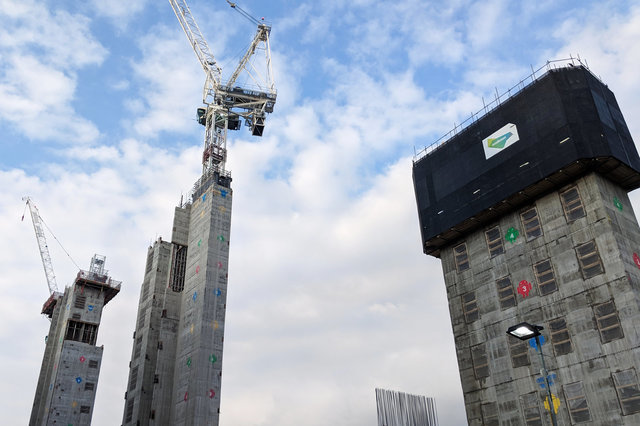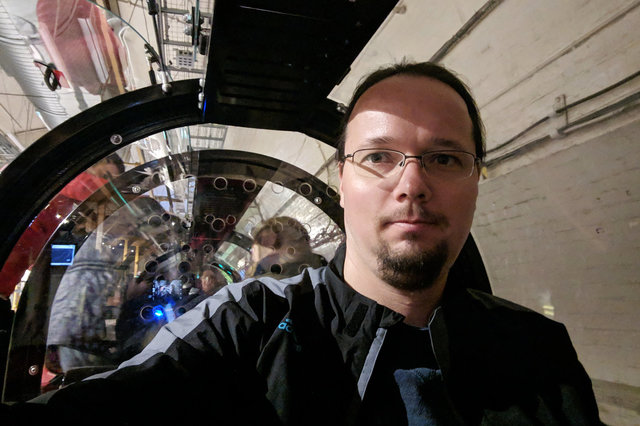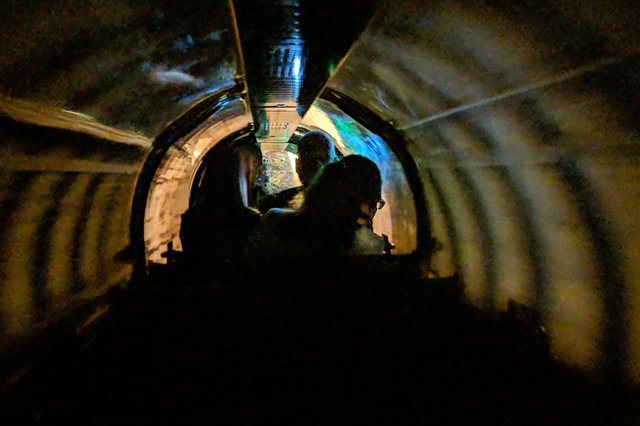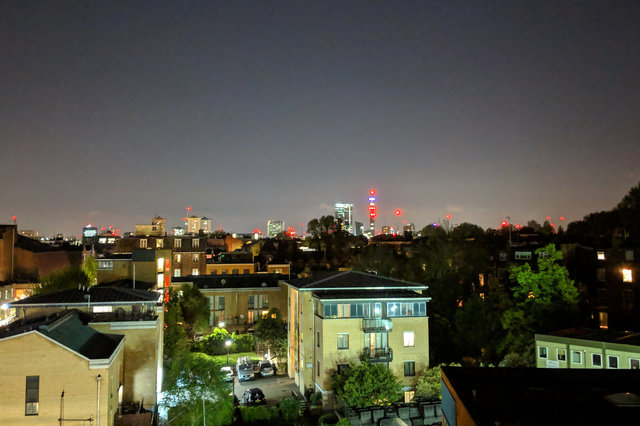Playing tourist in London
Started: 2019-05-27 20:09:31
Submitted: 2019-05-30 22:03:40
Visibility: World-readable
4th May 2019: In which the intrepid narrator rides an underground letter train in London
I gave myself one day to play tourist in London after spending the week at my employer's office, visiting my counterpart team there, before flying back to Seattle.
My first stop was breakfast at Dishoom, a highly-recommended Indian restaurant with locations around the city; I chose the one near Kings Cross, which was fairly conveniently close to me. (Dishoom had been recommended to me several years ago when I asked an Indian colleague in the office about veg Indian food in London; and also (independently) by my sister Bethany (who visits London with some frequency) and another colleague in the London office, both of whom pointed out that Dishoom was open for breakfast -- and that breakfast was the best way to bypass the long wait for lunch and dinner.)
I found Dishoom delightful for breakfast. The restaurant, according to its marketing copy, is inspired by the Parsi cafes in Mumbai; and if I squinted just right while sitting at the back of the dining room, looking across the checkerboard tiles on the tables and the other decorations, I could imagine that I was back in India, as if the light filtering down from the skylights was tinged with the pale yellow from the ever-present particulate air pollution, with ceiling fans languidly stirring the hot tropical air.
The food was good, too, starting with the chai and continuing to the scrambled soyrizo that was, somehow, obviously and perfectly Indian.
I left Dishoom and walked past Kings Cross Station, next to the elevator banks -- the only part of the building above ground -- climbing to the eleventh floor of the new Google Landscraper immediately next to the station. I continued walking to the Postal Museum, a recently-opened museum centered around the old Mail Rail tunnels, a network of tunnels dug under central London connecting most of the main-line rail station with the main post office with a narrow-gauge train running through it. The system was opened in the 1920s to let mail bypass the crowded streets of London, and remained in operation until 2003, when the impact of the Internet began to cause mail volumes to decrease, and improved automation elsewhere cut into the efficiency of the Mail Rail.
The centerpiece of the museum is a tour through the Mail Rail tunnels in a specialized narrow-gauge train built for tourists, running on the original tracks on a small subset of the original network.
The original tunnels were built for hopper cars carrying bags of mail, and were fully automated, running from a third rail; but for tourist operation the trains were battery-powered and operated by a human driver. The passenger carriages could seat two abreast on a bench (if the two passengers knew each other well); I was comfortable on a bench by myself. The top of the carriage was protected by a clear Plexiglas canopy, providing good visibility into the surrounding tunnels, but making it difficult to take many pictures from inside the train.
The route started and ended at the Mail Rail's old maintenance depot, then descended into the network of tunnels leading to the basement of the main post office. The train stopped at the platforms where mail had been loaded and unloaded on the train and projected onto the walls of the tunnels a movie-like presentation of the history of the Mail Rail and its operations.
The train continued through the tunnels, with announcements pointing out interesting features of the system: where side tunnels diverged and converged and where derelict rolling stock had been left in a junkyard for spare parts. I studied the construction of the tunnel as we traveled: most of the sections were iron bolted together like an Underground tunnel, only on a smaller scale; some tunnels were large enough for an adult to stand, while others were scarcely larger than the diminutive mail carriages. I couldn't help but think what sort of underground mail-delivery system Moist von Lipwig might come up with if given the chance.
I emerged from the Mail Rail ride into an exhibit further describing the history and operation of the system, complete with historical exhibits (especially older rolling stock) and interactive exhibits targeted at children (some of which I also found amusing).
I returned to the main Postal Museum and walked through the galleries, presenting the history of the Post with more artifacts and interactive exhibits. I learned that letter drops bearing the royal identification of Elizabeth II were the target of vandalism in Scotland because she is in fact the first Elizabeth crowned queen of Scotland (since England's Elizabeth I ruled before the unification of the crowns of England and Scotland); as a compromise letter drops in Scotland now bear the emblem of a thistle.
I ate lunch at the museum's cafe, then headed to my favorite museum in London, the Victoria and Albert Museum. I wandered through the galleries, many of which I'd seen before; but I paid special attention to the Cast Courts -- and especially the interior of the cast of Trajan's Column, which was recently opened to let visitors look inside at the brickwork (looking very much like a chimney from the inside) built to support the casts of the original column in Rome.
I was especially interested to see the new additions to the "Rapid Response Collecting" gallery, showing the museum's ongoing efforts to collect new works, mostly (but not exclusively) of commercial design demonstrating significant interplay between human society and industrial design -- like Snapchat Spectacles or Google Glass.
The adjacent gallery showed triumphs of industrial design from the past few decades -- including a Handspring Visor, an original iPhone, an iPad; a mass-produced porcelain statue of Chairman Mao (which the curators used to discuss art as state propaganda); and the hulking ugly misshapen lump of plastic that was the final outcome of the Toaster Project, in which an artist tries to build a toaster from scratch to understand why one can buy a toaster for £5 at the corner Tesco; and discovers how truly specialized the global economy really is.
(I still want to see an ethnographic display of hand-held artifacts from modern life: a display case full of nothing but disposable ball-point pens, none of them alike; or mechanical pencils; or Palm Pilots and other turn-of-the-century handheld computers; or pre-smartphone cell phones; or portable music players.)
I left the V&A, stepped outside to get a picture of the front of the building (the easiest way to get to the museum is via a tunnel from the South Kensington tube stop, thwarting me of the proper view of the building's imposing facade) and caught the sub-surface tube line one stop to the west to Gloucester Road.
Gloucester Road is important to me because it was the tube stop next to the hotel where Kisea and I stayed when we visited London in 2006 -- so basically I still consider it "my" tube stop. On our earlier visit one of the platforms had been given over to art; this time, the platform was covered in a somewhat-bizarre art installation "My name is Lettie Eggsyrub", apparently imagined as an eighties platformer video game.
I took the sub-surface lines a few stops east to Westminster and followed the crowds of tourists out of the station to gawk at the Houses of Parliament, especially the Elizabeth Clocktower, covered in scaffolding except for the clock face. It was raining again; I stayed under the protective awning of Portcullis House before retreating for the dry safety of the station, with the massive support columns for the building over our heads visible crisscrossing the wide-open spaces of the station box going down multiple stories beneath the surface to the Jubilee Line platforms.
I caught the Jubilee Line to London Bridge, on a circuitous route that took me south of the Thames for the one and only time on my trip, and caught the Northern Line to Kings Cross, where I ate supper at Mildred's, my favorite veg restaurant in London, before returning to my hotel in Camden for one last night before heading back to Seattle.













